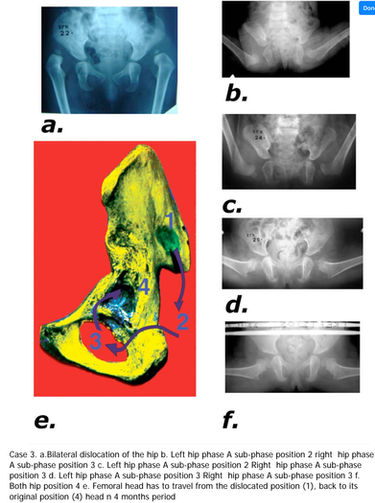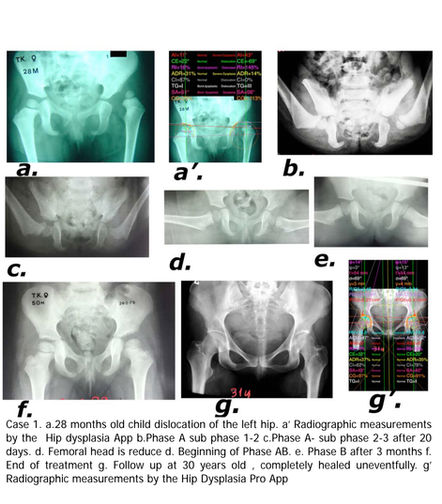The main doctrine is the younger the age the better the possibilities of successful and long lasting recovery. Functional conservative methods with different types of splint and braces have been applied to treat dysplasia of the hip with great success.
The general consensus that exists is that hip dislocation in patients older than the age of 18 months should primarily be treated surgically. All of our patients have been treated conservatively with the modified method of Hoffmann Daimler with success. The highest reported success of operative treatment in this age group was 75% but also the rate of avascular necrosis of the femoral head was 20/40%.
The concept of succeful treatment of developmental is dysplasia of the hip both in conservative as well in open surgery is first to reduce the femoral head and once reduced inside the acetabulum then to leave the acetabulum to remodel. If a concentric stable and well contained hip cannot be established by the age of four, the prospect of residual dysplasia and disability is almost universal.
IF DDH is left untreated or the treatment is failed, it can lead to serious consequences for the rest of the life of the individual. This depends on the degree of luxation of the hip. The following case depicts a case of failed treatment of a patient with DDH, who ends up with premature osteoarthritis of the hip .
The abnormal hip shape would lead to altered mechanics and in adolescence fatigue pain and limp may develop, which progressively will lead to osteoarthritis of the young adult, necessitating joint replacement at an early age.

The modified Hoffmann Daimler (mHD) method seems to achieve safe and lasting reduction with the lowest possible incidence of avascular necrosis and residual acetabular dysplasia in late presented , neglected or failed to be treated successfully DDH cases, which are thought to be too old to be treated with any functional method. The modified Hoffmann-Daimler functional method for the treatment of developmental dysplasia of the hip achieve safe and lasting results even in children older than 4 years of age without open surgery. JBJSA 2007 see above publication.
Cases treated with the modified HD method

a.Bilateral dislocation of the hip b. Left hip phase A sub-phase position 2 right hip phase A sub-phase position 3 c. Left hip phase A sub-phase position 2 Right hip phase A sub-phase position 3 d. Left hip phase A sub-phase position 3 Right hip phase A sub-phase position 3 f. Both hip position 4 e. Femoral head has to travel from the dislocated position (1), back to its original position (4) head n 4 months period

a.Bilateral dislocation of the hip b. Left hip phase A sub-phase position 2 right hip phase A sub-phase position 3 c. Left hip phase A sub-phase position 2 Right hip phase A sub-phase position 3 d. Left hip phase A sub-phase position 3 Right hip phase A sub-phase position 3 f. Both hip position 4 e. Femoral head has to travel from the dislocated position (1), back to its original position (4) head n 4 months period

The modified Hoffmann Daimler (mHD) method seems to achieve safe and lasting reduction with the lowest possible incidence of avascular necrosis and residual acetabular dysplasia in late presented, neglected or failed to be treated successfully DDH cases, which are thought to be too old to be treated with any functional method. The modified Hoffmann-Daimler functional method for the treatment of developmental dysplasia of the hip achieve safe and lasting results even in children older than 4 y

a.Bilateral dislocation of the hip b. Left hip phase A sub-phase position 2 right hip phase A sub-phase position 3 c. Left hip phase A sub-phase position 2 Right hip phase A sub-phase position 3 d. Left hip phase A sub-phase position 3 Right hip phase A sub-phase position 3 f. Both hip position 4 e. Femoral head has to travel from the dislocated position (1), back to its original position (4) head n 4 months period

dysplasia, Radiological, radiography, X-Ray, measurement, classification,Acetabular, index, AI, angle, DDH, hip, app, orthopaedic, measure, radiographic, developmental, angle, index, Smartphone, i-phone, Apps, applications, Mobile, DDH, developmental, orthopaedic, pain, acetabular, pelvic, femoral, head, triradiate , cartilage, ossification, sourcil, instability, laxity, roof, dysplastic, borderline, weight-bearing, inclination, congruence, incongruency, luxation, dislocation, subluxation, perce



dysplasia, Radiological, radiography, X-Ray, measurement, classification,Acetabular, index, AI, angle, DDH, hip, app, orthopaedic, measure, radiographic, developmental, angle, index, Smartphone, i-phone, Apps, applications, Mobile, DDH, developmental, orthopaedic, pain, acetabular, pelvic, femoral, head, triradiate , cartilage, ossification, sourcil, instability, laxity, roof, dysplastic, borderline, weight-bearing, inclination, congruence, incongruency, luxation, dislocation, subluxation, perce
Our team in Orthopractis.com frequently serves patients across the globe seeking excellent treatment for their child by conservative means without operations. We offer the application of splint and braces of Hoffmann Daimler in outpatient setting follow up can be accomplish by out-patient visits usually every two months follow up and regular check can be done also by Skype sessions -X-Rays also can be forwarded by e mail. Orthopractis.com arranges in certain patients translation services, work with international insurance carriers, and arranges lodging and transport .
or call for more details at +30 6944250035
Frequently asked question for the treatment. 1. My 18 month old child has been diagnosed with developmental dysplasia of the left hip. Orthopaedic surgeons usually suggest that the only treatment is surgery. Can I treat my child conservatively, without surgery, with the modified Hoffmann Daimler method? In our practice we have treated successfully conservatively even children with completely dislocated hips at 4 years of age (see cases). 2. Is the modified Hoffmann Daimler method applicable in my country? As far as we know, we are the only medical center in the world, who developed and applied successfully this method to 324 children. Some of them are published in 2007 in American Journal of Bone and Joint Surgery 3. How many times do I have to visit your orthopaedic practice in order to successfully treat my child? This depends on the degree of dislocation of the hip. Once the femoral heads are reduced, the average visits are one in every two months. 4. What are the advantages of conservative treatment? According to long-term results, operation is less successful than conservative treatment. Operation also jeopardizes the life of the child and during operation many complications can ensue. In contrast, as it is explained, after placing the hips in abduction and flexion nature does the rest of the job.The accidental disruption during surgery of the miniascule vascularity of the femoral head can lead to avascular necrosis os the femoral head which can be detected later in the life of the child where the femoral head is not spherical and ends with premature arthritis and limp. 5. Does my child require in-hospital treatment? The m-HD method does not require in-hospital treatment. The visits are customised according to each case. However, if the social setting is poor, we prefer that parents visit us every week. If the parents are not reliable at all and cannot comply with the scheduled visits -especially at the first critical weeks of reduction- we prefer in-hospital treatment for better surveillance. Poor applications of the harness, inadequate supervision or lack of compliance by the parents are factors which can lead to failure. We minimized poor compliance due to long duration of treatment by better parent education regarding developmental hip dysplasia or dislocation and harness use. 6 .My surgeon offers me the Pavlik method as conservative treatment why is preferable the modified Hoffmann Daimler method ? Pavlik method gained much popularity because Pavlik was the first how applied succefully this kind of functional conservative treatment. But Pavlik harness can be applied in infants not older than 8 months of age because is very difficult to hold the leg from the ankle in the preferred position -flexion and abduction- and the next option commonly at this age is the surgery and open reduction . The Hoffmann Daimler Harness is superior because you can hold to leg from femurs and thus it can be applied in older children- till 4 years of age- in cases where reduction needed . The concept and the method of the Pavlik and Hofmman Daimler are the same the difference is in the way that hold the leg.
More for the method at book store








